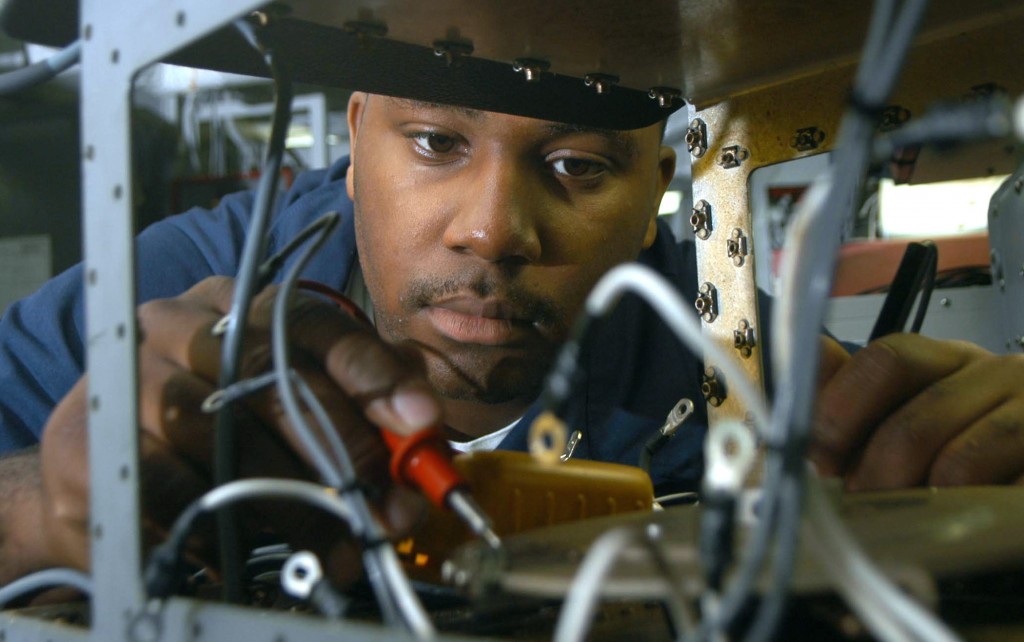Across the country, states find themselves in a seemingly paradoxical situation: high youth unemployment, coupled with thousands of unfilled jobs in the skilled-trades. In Washington, the situation is particularly acute in manufacturing and construction, which contribute 54.5 and 13.66 billion respectively to the state’s GDP.
This situation is not just bad for business, it’s bad for Washington residents, who are losing out on high-paying jobs. This discrepancy between employer needs and human capital demands closer scrutiny of higher education. In the United States, higher education has become synonymous with four-year degrees, and this may just be the source of our problem.

The Skills Gap
Nationally, an estimated 3 million jobs are available in the skilled trades, and these numbers are growing fast. Job openings in these fields are projected to outstrip the supply of skilled workers by three-to-one starting in 2016. For the last three years, according to ManpowerGroup, the largest shortage of skilled workers amongst electricians, plumbers, manufacturing workers, pipefitters, mechanics, appliance repair, computer techs, and welders. These professions drive Washington’s biggest industries.
One of the primary factors driving this shortage is the rapidly aging demographics of blue collar workers. In 2012, 53% of skilled trade workers were 45 years or older, compared to 44% of the overall workforce.
The Value of Apprenticeships
There is renewed enthusiasm for technical and vocational training in the form of apprenticeships, a model that is popular and successful in other countries but has failed to take off in the United States. Washington stands to gain from expanding its existing network of apprenticeships and providing trade-related industries with desperately needed human capital.
The Workforce Training and Education Coordinating Board’s 2015 report states that “Labor market outcomes for apprentices are significantly higher than for other programs the Workforce Board studies.” 86 percent of apprentices report employment within 9 months completing their program, with a median wage of $30.47 per hour. The taxpayer return on investment for apprenticeships is also significantly higher than that of any other workforce-training program, accruing $23 in net taxpayer benefit for every $1 invested by the state.

The German Model
In Europe, apprenticeships represent a highly respected education pathway, spanning a wide range of professional fields. Germany has a renowned apprenticeship program, and many believe that it explains why the country maintains the lowest youth unemployment rate of any industrialized nation in the world— between 7 percent and 8 percent.
In Germany, students can apply to for paid training programs at private companies before the age of 18. If accepted, the government supplements the trainee’s on-the-job learning with classroom instruction at a publicly-funded vocational schools. Apprentices also receive a state certificate after passing standard industry-specific exams, demonstrating the relevance of their training.
Germany’s model, however, depends heavily on state investment, and has been deemed unreplicable in most states.
The State of Apprenticeships in the U.S.
Today in America, fewer than 5 percent of young people train as apprentices. In Germany, the number is closer to 60 percent. Despite a brief period of national enthusiasm for apprenticeships in the 1990s, the issue stagnated by the early 2000s. It has been picked up by the Obama administration, which recently announced its plan to issue $100 million worth of apprenticeship grants, along with a plan to spend another $6 billion over the next four years.
Private groups are getting involved as well. The plan by the Associated General Contractors of America, which represents 30,000 companies, aims to draw more people into building trades by establishing charter schools focused on technical training and starting non-union apprenticeship programs.
What Gives?
Some people refer to the scarcity of trade-related workers as the “middle skills gap.” This gap stems from a host of factors that can be separated into two categories: the general neglect of vocational education and the psychology that supports it.
The biggest hurdles to overcome regarding apprenticeships are beliefs about “blue-collar” work and late adolescence. The stigmatization of blue collar work occurred alongside a growing obsession with four-year colleges, despite the fact that many college graduates face unemployment or underemployment upon graduation. In addition to a more nuanced assessment of four year degrees, making apprenticeships a centerpiece of American higher education, would require a cultural shift away from viewing late adolescence as a time of exploration.
There is also opposition from academia. The value of apprenticeships lies primarily in their utility, which rubs up against the idea that higher education should be (at least in part) about personal growth. The popularity of liberal arts education is a manifestation of this perspective. In a column in The Washington Post, the presidents of the University of Michigan and Stanford cautioned against evaluating components of higher learning based on their utility, for fear of marginalizing humanities and social sciences. Educators from community and technical colleges, which serve fundamentally different demographics than four-year institutions, often retort that this is a privileged perspective on the function of higher education. Most low-income students are not looking to accrue tens of thousands of dollars in debt for a personal growth experience.
Check out www.careerbridge.wa.gov to view educational programs based performance metrics!
Let’s Talk Specifics
Washington currently has 181 active, registered apprenticeships. The majority of apprentices report employment in construction (52%), followed by services (15.9%) and manufacturing (8.5%).
In addition to some of the cultural barriers mentioned above, some site costs and opposition to regulation as obstacles for companies to invest in apprenticeships. Luckily, Washington has already overcome some of these logistical hurdles. In Washington, apprenticeships are registered with the Washington State Apprenticeship and Training Council and administered with the Department of Labor and Industries, solving the problem of unified state standards.
Many companies in Washington have reduced the cost of building apprenticeships by partnering with community colleges. For instance, Boeing partners with South Seattle Community College for its apprenticeship program. Other companies see the value in establishing and running independent programs because they can update training to keep pace with new technologies and best practices. This is the case for the Iron Workers.
Tim Wilson, the Apprenticeship Program Manager at Labor & Industries, says that it costs very little for companies to set up apprenticeship programs if they choose to partner with CTCs. They basically pay to hire someone at a reduced cost. And for those who choose to remain independent of the college system, the return on investment is enough of an incentive to invest in an apprenticeship program.
For trainees, the connections between apprenticeships and community colleges offer additional incentives. In Washington, many apprenticeship programs often count as certificates at community colleges that can be “stacked” toward an associate’s degree.
Other States
South Carolina is often touted as a leading example of workforce development. In 2007, the state started Apprenticeship Carolina, which has grown the number of participating companies from 90 to 670, and the number of apprentices from 777 to nearly 11,000 apprentices since its inception. The South Carolina Workforce Investment Board allocated $1 million in grant funding to jumpstart participation among schools and businesses, and the state gives a $1,000 tax credit for every apprentice hired.
To be fair, South Carolina’s owes part of its success to pre-existing circumstances. The state has strong ties to European companies, which have been willing to finance apprenticeship programs and are major employers in the state (German companies alone employ about 28,000 workers). These companies have even established programs with local high schools. Additionally, the cost of doing business is relatively low in South Carolina. labor costs The state’s median hourly wage is $14.74 per hour, compared to $19.76 in Washington. South Carolina also has lower business taxes and regulations.
Other states are beginning to latch on to the idea of apprenticeships as well. Iowa recently budgeted $3 million per year to help businesses and trade unions pay for the startup costs of apprenticeship programs. In Kansas, the Workforce Investment Board pays the cost of instruction for apprentices, and Maryland’s Workforce Investment Board gave $50,000 to the state apprenticeship agency to market apprenticeships.
What can Washington Do Better?
- Give Preferences to Companies Who Hire Apprentices. This year, the Washington legislature failed to pass a bill extending requirements for apprenticeship utilization. The bill would have required at least 15 percent of labor hours on subsidized public works projects estimated to cost $5 million or more be performed by apprentices.
- Target High Schoolers. This can be done by expanding the availability of Career & Technical Education in high schools and the Running Start program for CTE. Other states have also approved technical high schools. New York, for example, established the ‘P-Tech’ school, a collaboration between IBM, the City’s Education Department and CUNY (17).
- Finance Apprenticeships. In 2008, the Washington legislature financed the establishment of the Aerospace Joint Apprenticeship Committee to support the aerospace sector. To date, this program has been one of the state’s most successful workforce training initiatives.
- Promote Career Readiness Certificates. These certificates, while not yet commonplace, serve as workforce credentials that reflect competencies demanded by employers. In Washington, only 8 companies accept these certificates.
- Tax Credits. Some states, Washington not included, offer tax credits to companies who hire apprentices to further reduce costs. Last year, a bill proposed Senator John Braun, establishing a tax credit for employers participating in apprenticeship programs, failed to pass the legislature. States that offer these tax credits report that they are most helpful to small and medium sized businesses.
The Time Is Now
While it seems that the youth unemployment crisis has not been enough to increase investment in alternatives to four-year degrees, the threat to Washington’s economy should be. In Washington, manufacturing and construction companies are enjoying unprecedented growth in the face of an unprecedented loss in their workforce. Boeing alone is set to lose 60% of its workforce over the next five years.
Tim Wilson of L&I sees a connection between workforce shortages and slow economic growth, explaining that people without well-paying jobs aren’t spending money, and therefore are not stimulating the economy. People who go through apprenticeships on the other hand “are not just building the houses, they’re buying them.”
Economics aside, education has long been revered as society’s “great equalizer.” If Washington wants this time-worn quote to ring true, the state needs to start thinking about education in terms of ROI. That means investing in apprenticeships.
